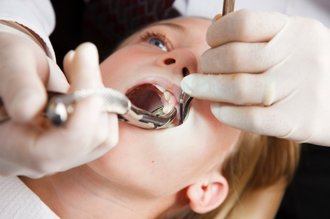
After your tooth has been removed, gauze that has been “cubed up” is placed on the extraction site. Firm biting on the gauze applies pressure on the site in order to stop the bleeding. When arriving home the gauze can be discarded. If left too long it attaches to the clot! Apply an ice pack on your face near the extraction--15 minutes at a time for the first 24 hours. Remember first aid: pressure and cold stop bleeding. Note that a little bit of bleeding mixed with a lot of saliva can create the illusion of a lot of blood. If you think the bleeding has not stopped, simply cube up another gauze, enough to exert pressure on the site when you bite, and squeeze your jaws together. You may also apply finger pressure on the gauze. In about 30 minutes, the bleeding should stop, unless there is a clotting problem. Keep icing to slow blood flow. Call Dr. Kulick directly at (440) 503-9685 (cell phone) if you are unsure.
Also crucial to healing is to leave the site undisturbed once the bleeding is stopped and the clot is formed. Do not rinse for the first 48 hours.There is a tendency to want to rinse thoroughly because of the taste of blood. This will rinse the clot out of the socket and leave the site susceptible to infection. The blood clot is the initial barrier against bacteria. Eventually, gum tissue grows over the clot and the clot turns into bone. The fuller the clot, the more likely the area will heal without a divot.
When eating, chew slowly and swallow carefully. Take small bites, and be conscious not to let food push toward the extraction site. This is most critical during the first day after a tooth has been removed.
Strenuous physical activity, smoking, forceful spitting, and/or strong pulling through a straw can also cause problems with healing. These things should be avoided. (People often drink milkshake-type drinks for nourishment after a tooth has been pulled. If they are thick, pulling through a straw can pull the clot out of the socket!)
Medication may be prescribed if the doctor deems it necessary. Antibiotics help control infection, and pain medication helps to control both pain and swelling. If meds are prescribed, use them. Many times people comment that they do not like to take pain medication, and the area swells up with pain unnecessarily. Taking pain medication before the local anesthetic wears off, controls pain and swelling better and healing is often faster.
